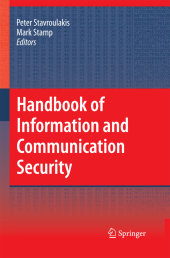 Neuerscheinungen 2014Stand: 2020-02-01 |
Schnellsuche
ISBN/Stichwort/Autor
|
Herderstraße 10
10625 Berlin
Tel.: 030 315 714 16
Fax 030 315 714 14
info@buchspektrum.de |

Mark Stamp, Peter Stavroulakis
(Beteiligte)
Handbook of Information and Communication Security
Herausgegeben von Stavroulakis, Peter; Stamp, Mark
2010. 2014. xvi, 867 S. 235 mm
Verlag/Jahr: SPRINGER, BERLIN; SPRINGER BERLIN HEIDELBERG 2014
ISBN: 3-642-44459-8 (3642444598)
Neue ISBN: 978-3-642-44459-3 (9783642444593)
Preis und Lieferzeit: Bitte klicken
The Springer Handbook of Information and Communication security provides I & C professionals, researchers as well as students with quickly retrievable information on relevant security topics.
At its core, information security deals with the secure and accurate transfer of information. While information security has long been important, it was, perhaps, brought more clearly into mainstream focus with the so-called "Y2K" issue. Te Y2K scare was the fear that c- puter networks and the systems that are controlled or operated by sofware would fail with the turn of the millennium, since their clocks could lose synchronization by not recognizing a number (instruction) with three zeros. A positive outcome of this scare was the creation of several Computer Emergency Response Teams (CERTs) around the world that now work - operatively to exchange expertise and information, and to coordinate in case major problems should arise in the modern IT environment. Te terrorist attacks of 11 September 2001 raised security concerns to a new level. Te - ternational community responded on at least two fronts; one front being the transfer of reliable information via secure networks and the other being the collection of information about - tential terrorists. As a sign of this new emphasis on security, since 2001, all major academic publishers have started technical journals focused on security, and every major communi- tions conference (for example, Globecom and ICC) has organized workshops and sessions on security issues. In addition, the IEEE has created a technical committee on Communication and Information Security. Te ?rst editor was intimately involved with security for the Athens Olympic Games of 2004.
Part A Fundamentals and Cryptography
A Framework for System Security .- Public-Key Cryptography.- Elliptic Curve Cryptography.- Cryptographic Hash Functions.- Block Cipher Cryptanalysis.- Chaos-Based Information Security.- Bio-Cryptography.- Quantum Cryptography.-
Part B Intrusion Detection and Access Control
Intrusion Detection and Prevention Systems.- Intrusion Detection Systems.- Intranet Security via Firewalls.- Distributed Port Scan Detection.- Host-Based Anomaly Intrusion Detection.- Security in Relational Databases.- Anti-Bot Strategies Based on Human Interactive Proofs.- Access and Usage Control in GRID Systems.- Secure Human Identification.-
Part C Networking
Peer-to-Peer Botnets.- Security of Service Networks.- SCADA Security.- Mobile Ad-Hoc Network Routing.- Security Approach for Ad-Hoc Networks.- Phishing: Attacks and Countermeasures .-
Part D Optical Networking
Chaos-Based Secure Optical Communications.- Chaos Applications in Optical Communications.-
Part E Wireless Networking
Security in Wireless Sensor Networks.- Secure routing in Wireless Sensor Networks.- Security Via Surveillance and Monitoring.- Security and QoS in Wireless Networks.-
Part F Software
Low-Level Software Security by Example.- Software Reverse Engineering.- Trusted Computing.- Security via Trusted Communications.- Viruses and Malware.- Designing a Secure Programming Language.-
Part G Forensics and Legal Issues
Fundamentals of Digital Forensic Evidence.- Multimedia Forensics for Detecting Forgeries.- Technological and Legal Aspects of CIS
Subject Index


